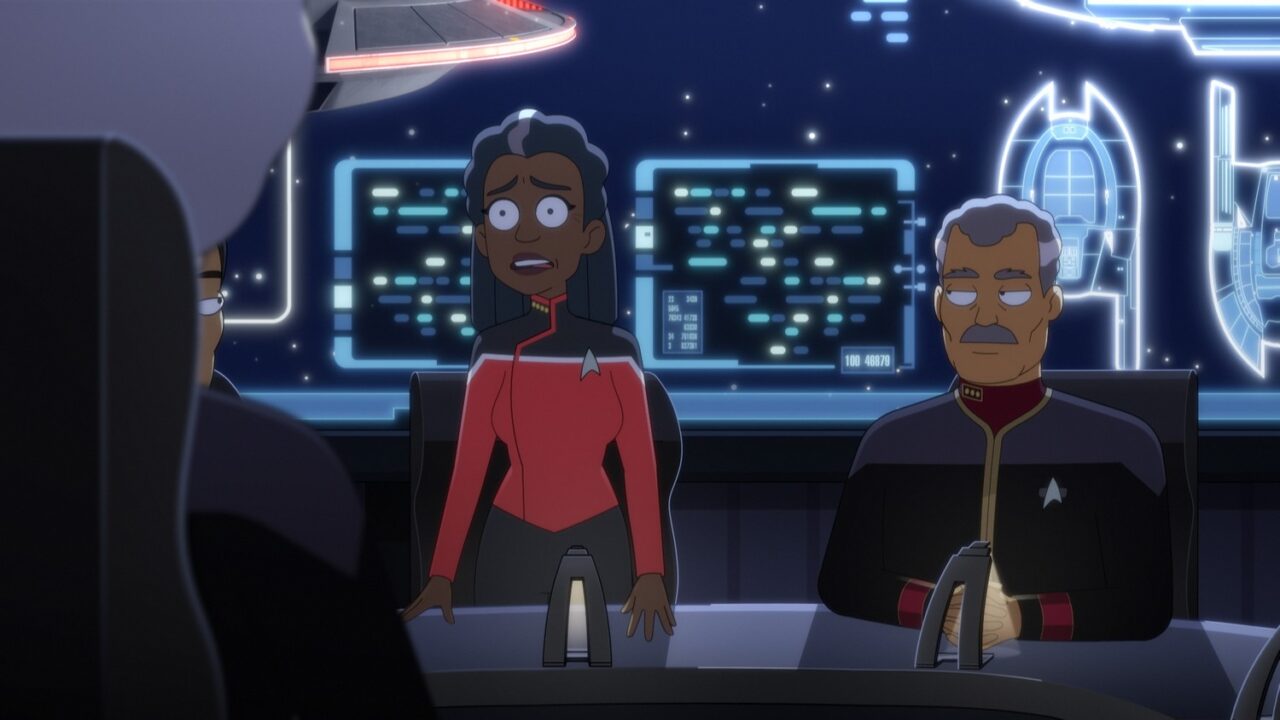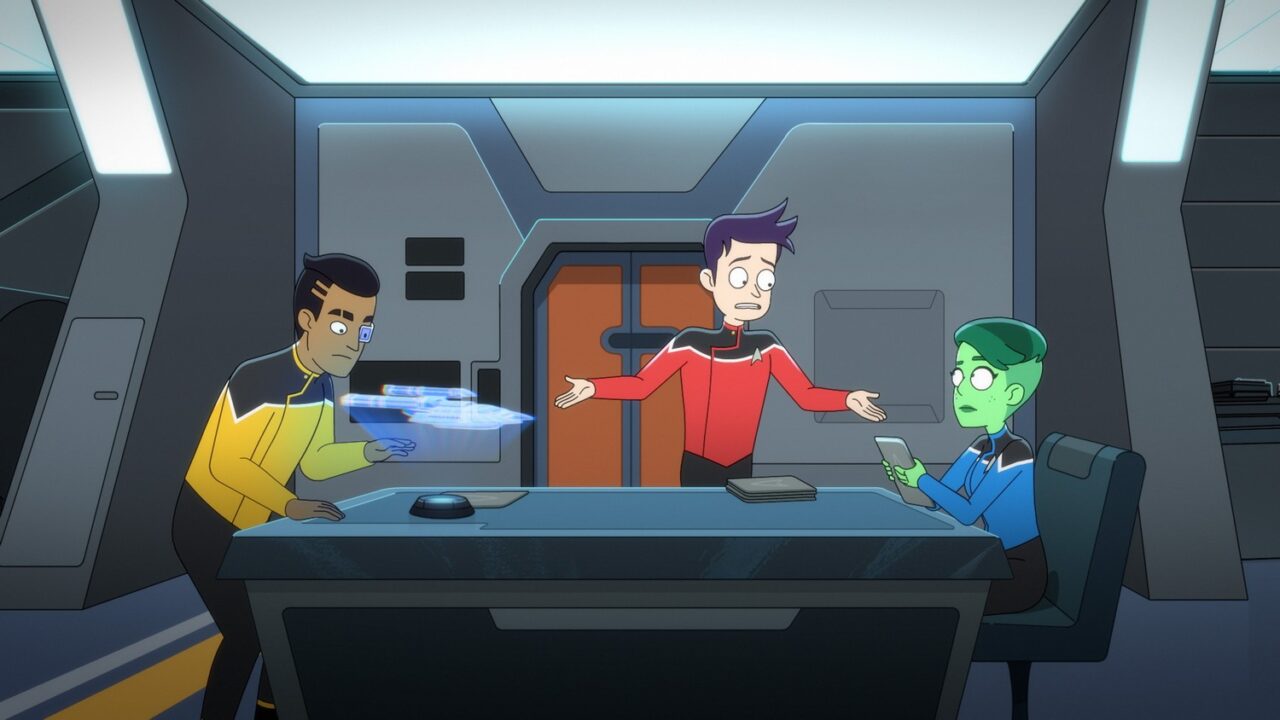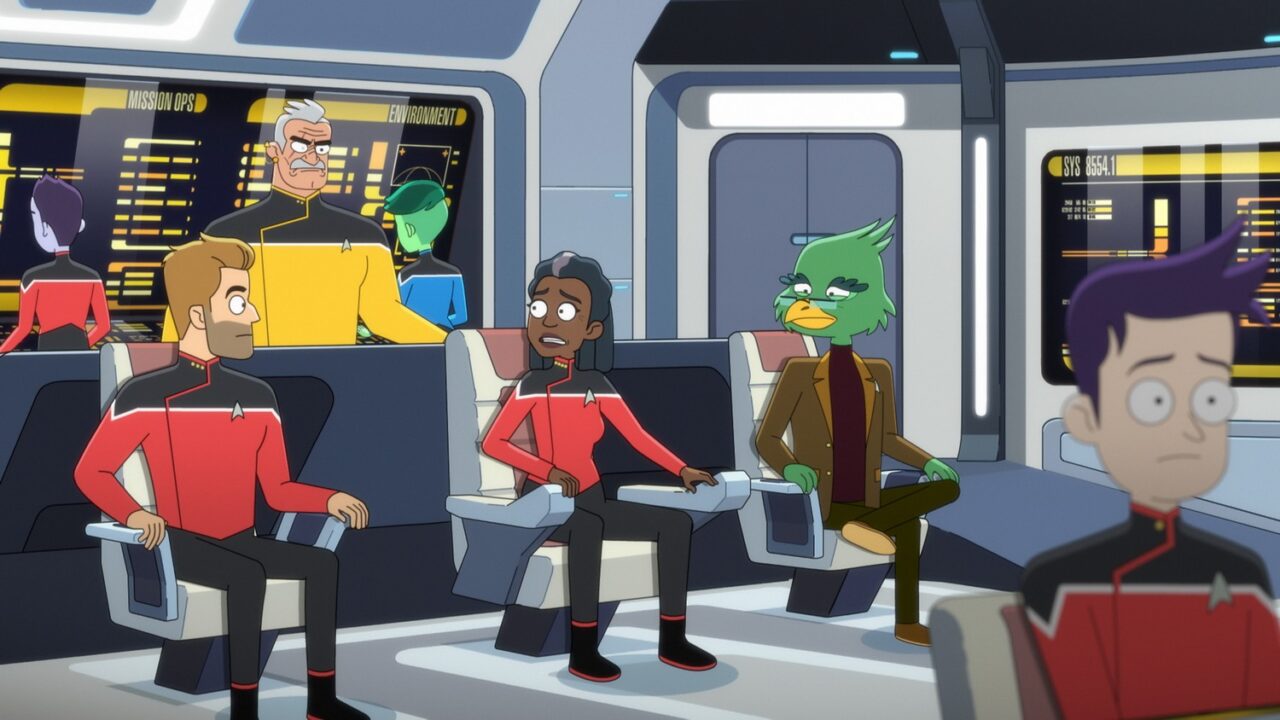For those who study fiction writing, certain story structures will become extremely familiar. The one that’s often taught for commercial fiction, and one I’ve seen in most popular movies these days, follows this basic pattern: inciting incident, rising action with small setbacks on its way to a grander goal, a huge fail that seems insurmountable (what I call the “pit of despair”), followed by an EVEN HUGER TRIUMPH that ends the story on a euphoric note (Think the Emperor defeating Luke in Return of the Jedi… and then Vader’s 11th-hour return to the light side. Or the ending of every Pixar movie ever). Some balk at the concept of following basic story structures, claiming it makes plots formulaic. I say it’s a tool, and when used well, is absolutely exquisite to experience.
The third season of Lower Decks has given us more of an overall story arc than the first two, planting the seeds of a larger plot throughout its fun, irreverent episodes. And it’s all been leading to this finale, which wields that pit-of-despair-to-euphoric-triumph structure with aplomb.
We start the episode in the pit of despair. The penultimate episode, “Trusted Sources,” left me absolutely gutted after Mariner was kicked off the Cerritos by her own mom after everyone thinks she trashed the ship and its crew to a reporter (she didn’t, but given her behavior over past episodes, it’s easy to see why everyone thought she did). The Cerritos was totally pommeled by an unexpected Breen attack and had to be rescued by a new type of automated ship, the Texas class, and of course that reporter roasted their reputations.

The finale, “The Stars at Night,” picks up where “Trusted Sources” left off. The Cerritos is being repaired, and Captain Freeman must face the music for her perceived failure. Admiral Buenamigo, who’d authorized last week’s Project Swing-by second contact mission and also spearheaded the Texas class project, proposes that the Texas class should take over support missions entirely. Meaning the entire California class of ships to which the Cerritos belongs would be decommissioned, all those crew members replaced by a few machines. To Freeman’s dismay, the council agrees.

Word spreads to our remaining lower deckers, Boimler, Tendi, and Rutherford. The first two are understandably upset and freak out about their futures in Starfleet. Rutherford, however, nerds out to the Texas-class ship Aledo‘s code. To lighten the mood, Boimler starts doing impressions of the bridge crew. You know it’s coming: one of them walks in as he’s doing an impression of them. And it’s Shaxs. Who’s had a special fondness for “Baby Bear” Boimler since the latter joined his Bajoran dirge choir. And who, despite his gruff, growl-y persona, is a big ol’ softie and deeply hurt (despite Boimler’s hasty apologies).
Meanwhile, Mariner is living out an ethical Indiana Jones-style adventure of stealing artifacts from black-market traders and returning them to the museums of the cultures those artifacts belong to, with fellow Starfleet dropout Petra Aberdeen. But when Mariner asks who’s funding their missions, Aberdeen gets cagey.
Lower Decks initially billed itself as being about the lowest ranking officers on the least important ship in Starfleet. Now, Starfleet itself has decided that the Cerritos and all ships like it are so unimportant, they can be replaced by a big shiny drone. Of course, Freeman isn’t about to let her ship and her peers go down without a fight. So she challenges the Texas-class ship, the Aledo, to a mission-off. It’s that age-old sci-fi classic: man vs. machine. (Actually, come to think of it, the tale of John Henry predates sci-fi…)
The council agrees to let the the Cerritos race the Aledo to complete three support missions before chucking the whole California class into the dustbin. The whole crew goes into Hustle Mode to get it done.
First mission: Galardon for some equipment repairs and updates. The crew goes into overdrive to get it done, but the Aledo is able to drop a whole new structure onto the planet.
Second mission: LT-358, an uninhabited planet, to build an outpost. Once again, the crew springs into action. But then Tendi’s scan indicates the possibility of microscopic life forms, and all work is halted so the crew can test to see whether they’re sentient, and therefore whether building the outpost would be an ethical violation. The Aledo has no such qualms. It drops its outpost and warps out. Dr. T’Ana confirms that the life-form reading was false, and the crew scrambles to complete the mission.
Third mission: Ockmenic 9, a planet that, for some sci-fi dimension-shifting reason, only appears for a few hours once every few years, to drop off supplies. The Aledo pops in and transports the supplies. By the time the Cerritos arrives, the planet has already disappeared again.
And so, as is often the case in these kinds of stories, the machine won. But also, as is often the case with these kinds of stories, its ruthless efficiency missed a crucial ethical step – the part where the Cerritos had to double check that they weren’t stomping on a sentient microscopic life form’s way of life.
Freeman points this out to Buenamigo and argues that it proves the Texas-class ships aren’t fit for duty. At the same time, Rutherford realizes why he’s so obsessed with the code: It’s his! He’d written it before he got his implant! We finally get a payoff to the Episode 5 flashback where Rutherford saw a shadowy figure ordering his memories erased, and the person who gave that order was… *drumroll*
Admiral Buenamigo! Who wanted to leave a lasting impact on Starfleet with his automated ships, whatever the cost! Oh, and that thing with the Breen? He totally set up the Cerritos to fail there, just so his robot ship could save the day. When challenged by Freeman over a little thing called the Prime Directive, he loses his cool and orders the Aledo to go fully independent and attack the Cerritos.
In a neat tie-in to the first season, Rutherford confesses that his code had issues. It’s similar to what he’d used to create Badgey, a holodeck tutor that turned evil and murder-y. So, of course (midpoint reversal!) the Aledo goes all HAL-9000 the instant it gains independence from Buenamigo and blows up the admiral. It then activates two more Texas-class ships and starts laying waste to the space station while the Cerritos desperately tries to stop it.
Meanwhile, Mariner and Aberdeen arrive to drop off the artifact on its home planet. The moment Aberdeen leaves, Mariner, certain something nefarious is going on with their funding, starts digging into her private files. Aberdeen catches her and reveals that their mysterious benefactor is… Jean-Luc Picard. Who’s also passionate about archaeology, as Next Generation fans know (Sorry, Mariner, no evil plot for you to untangle)!
Mariner is obviously disappointed by how… normal… her new life is. She misses feeling like she’s making a difference in the galaxy (Aberdeen pointedly remarks that archaeology does make a difference, but we’re Trekkies and we see what you mean, Mariner). Aberdeen pulls up a newsfeed to show how much worse off Mariner would be with Starfleet, and the footage shows the attack the Cerritos is engaged in. Shocked, Mariner snaps into Hero Mode and insists that she and Aberdeen, in their little archaeology ship, must go help. Aberdeen objects but Mariner wins her over, and off the go to… take on a powerful murder robot ship in their barely-more-than-a-shuttle clunker? Hey, why not. Everyone loves a David vs. Goliath tale.
Freeman, hoping to save civilian lives, uses the Cerritos to draw the three Texas-class ships away from the space staton by dangling Rutherford in front of them. (Oh, you have daddy issues, evil murder robot ships? Here’s the guy who wrote your code! Come and get him!)
The Texas-class ships take the bait, and into warp they go. Now what? Everyone starts talking at once. Shaxs tries to make a suggestion but isn’t heard in the chaos and, still smarting from Boimler’s mockery, seems too insecure to try again. It’s Boimler who tells everyone – including *gasp* the captain – to “shut up and listen to Shaxs” (that’s his actual line). Shaxs proposes ejecting the warp core. It isn’t the first time he’s (over-eagerly) made this suggestion, but it makes sense this time. Dumping the warp core would drop the Cerritos out of warp while the giant hunk of machinery crashes into their pursuers, acting as a bomb to get rid of them once and for all. So Freeman orders him to make it so.
With stars in his eyes, Shaxs rushes through the Cerritos to the crew’s encouraging cheers and meets Billups in engineering. Together, they turn their keys, and out goes the warp core. Ka-boom! Triumph!
… or not. Two of the ships are destroyed, but the main baddie, the Aledo, survives. And it is not happy. The Cerritos, already heavily damaged, can’t even run away without a warp core. If the final moments of last week’s episode were the season pit of despair, then this is the episode’s pit of despair – the pit within the pit, the “all is truly lost” moment. Which means what comes next is…
TRIUMPH! Mariner shows up to save the day! In that little clunker? Of course not. The Aledo is too much for a California-class ship to handle, so she called all of them. Every city in Cali turns up to defend one of their own against the murder robot ship that tried to replace them. Friends and rivals and former crewmates (and weird doppelgangers) all have the Cerritos‘ back. Pew, pew, kaboom, bye-bye evil murder robot ship. People and ideals win, coldly efficient super machines and the unethical jerks who unleash them lose.
It’s that moment of euphoria that almost every piece of popular media strives to end on, and even though one could’ve seen it coming from a galaxy away, Lower Decks pulls it off splendidly. Anyone can apply the formula, but to execute it well is no small feat, and the show has done a great job of setting up this moment over the course of Season 3, dropping not only plot crumbs, but also moments of character development. Even minor things like Shaxs finally getting to eject the warp core and seeing the other California-class captains show up for the Cerritos feel like a giant reward for all the time we’ve spent with this show.
The Cerritos gets repaired, and everyone hangs out at the cafeteria. Mariner returns, where her friends greet her warmly and Boimler apologizes profusely for not defending her more when she got kicked off. In a show of character growth, Mariner confesses that her own behavior gave them reason to doubt her.
Tendi’s officer training is going so well that Starfleet sent someone to train with her: the “emotional” Vulcan girl from from Season 2’s “wej Duj.” Tendi is, characteristically, thrilled.
Boimler finally gets a bridge buddy in Shaxs, and Rutherford makes peace with his implant, which he finds too dang cool to resent even though it was used to exploit him.
Freeman apologizes to Mariner and has her reinstated, and Mariner seems ready to really commit to Starfleet this time, even choosing Ransom as a mentor (much to his dismay, in a hilarious reversal of the first episode‘s dynamics).
I was somewhat surprised to see this season wrap up so neatly, since the first two seasons both ended on cliffhangers. In fact, I thought they were going to draw out Mariner’s departure more, and possibly make her return to Starfleet a whole arc in the next season. I don’t really mind that she’s returned already, but I do think it could have been even more impactful if we’d had more than half an episode (just 10 minutes since these episodes are so short) with her away.
It was nice to see her character mature over the course of this season. Whereas the first two seasons mostly had her treading water as the arrogant, rebellious badass with a devil-may-care attitude that made you wonder why she was even in Starfleet if she hated its rules so much, the third has allowed her to grow up and recognize that this is indeed something she wants to do.
To a lesser extent, Boimler and Tendi have had a chance to grow too, with the former challenging himself to be, well, Bold Boimler, and the latter recognizing her own ambition and going for it. Rutherford has mostly been a plot device, with a bit of backstory added, but he was in a pretty good place to begin with and is always just fun to have around.
Despite being a cartoon comedy full of lowbrow gags and referential humor, Lower Decks has proved adept at both driving plots and developing characters as well as any prestige sci-fi drama… and better than many. The show’s format has given it permission to have fun in ways that the live-action Paramount+ Star Trek series lack, yet it never forgets that it is, first and foremost, Star Trek.

